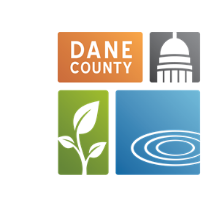
Locations of these priority harvesting areas are indicated on Harvesting Priority Maps. Harvesting is not prohibited in areas not marked on the maps. They are not, however, normally harvested due to very small rate of plant growth and budget limitations. Plant harvesting for visual appeal and collection of plant pieces due to boat propeller action generally cannot be done due to the limits of equipment, staff, and budget.
Priority #1 – Flood Mitigation (Keep Water Flowing Through the Yahara River)
This priority is assigned only to the Lower Yahara River between Lakes Waubesa and Kegonsa, where proactive harvesting is conducted to prevent high water issues, including possible flood conditions. Cutting and harvesting plants is generally confined to the deepest part of the river channel in order to maximize water flow downstream. Harvesting machine operators are also able to pick up large mats of floating plant fragments near the shoreline, which otherwise collect and rot around piers.
Priority #2 – Recreation and Navigational and Beach Access
To provide for recreation and navigational access, the harvesting machine operators usually cut and harvest a 30-foot strip parallel to shore, and 20-foot access lanes to open water. These cuts are normally 4 to 5 feet deep. The harvesting lanes are parallel to shore at a distance of 100 to 150 feet. This priority category includes harvesting done to provide access from private shorelines, public Lake Access Sites (boat landings), swimming beaches, and developed public shorelines.
Priority #3 –Shallow Cuts and Filamentous Algae Control
The Wisconsin DNR has approved a program on the Yahara River Chain of Lakes allowing for shallow cuts (2 to 3 feet deep from the surface) targeting specific invasive and nuisance plants. This provides better access for recreational activity. DNR is satisfied that the shallow cutting is not known to harm fish populations, and leaves the bottom part of the plant in place, which provides fish cover and stabilizes sediments. An aesthetic side benefit of these shallow cuts may be removing filamentous algal mats that are frequently found floating on top of the invasive and nuisance plants.
Priority #4 – Special Events
As time and budget permits, harvesting machine operators cut and harvest plants for special events held on or in the water. Only the smallest amount necessary for the event is cut. These priority areas are not mapped because locations vary.
Other – Deep Cuts
It has been shown that deep water cutting and harvesting of Eurasian Water Milfoil close to the bottom reduces competition and releases native plants when present. Deep cuts have also shown to improve fish habitat and increase overall size and age structure of the fish within the water body. The deep cutting may provide for extended access for swimming, boating and fishing within these sites without repeated harvesting. On the limited occasions when this cutting and plant removal is provided, Dane County uses a special harvester with a 16-foot deep and 6-foot wide cutting head. The operation is labor-intensive, as it requires a first pass with a regular harvester (4 to 6 foot cut), a pass by the deep cutter, and another regular harvester pass to pick up plant fragments. Dane County staff are confident that most plant fragments are collected in this process.
No-Cut Areas
Also shown on the harvesting priority maps are areas not cut for reasons as noted on the maps and listed below.
No-Cut Areas – Machinery Hazard
These are rocky or shallow areas where the harvesting equipment cannot operate due to potential damage to the equipment.
No-Cut Areas – Undeveloped Shoreline
These are undeveloped areas where access for motorized navigation is not needed. These undeveloped areas are identified to promote limited disturbance and promote vegetation growth. The areas are often consistent with the proposed Critical Habitat Areas from the aquatic plant management plans. They include important fish spawning and juvenile fish cover areas located outside of the typical harvesting lanes, where harvesting would reduce fish production.